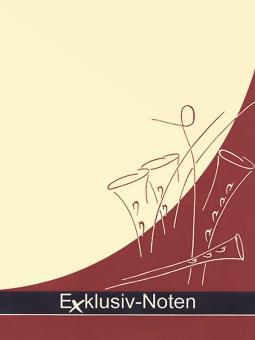The Beatles
Yesterday
Saxophone Quartet s/a-a-a/t-t/b
The Beatles
Yesterday
Saxophone Quartet s/a-a-a/t-t/b
- Compositor John Lennon Paul McCartney
- Intérprete The Beatles
- Adaptador Undine Engel
-
Dificultad
- Editorial Exklusiv-Noten
- Nº de pedido EXKL-SAX1029
plazo de entrega 1-3 días laborables
IVA incluido.,
Más gastos de envío
No disponible en todos los países. Leer más
Descripción de la:
World-famous, covered thousands of times and therefore not the typical material for an arrangement, because the risk of it sounding trite or having been heard too often is omnipresent. So why this arrangement?
Because my three fellow musicians in the quartet really like this title, whereas I myself have never paid much attention to the Beatles. Nevertheless, there are melodies that are broken down to such a minimum that they say everything and touch the soul. This is the case with Yesterday. You don't need the (melancholy) lyrics; the music and its chord sequences say it all.
This arrangement can be played with flexible instrumentation, even without baritone saxophone. The SATB instrumentation is ideal, however, because from bar 34 the tenor takes over the melody in the bridge, but is constantly surrounded by the soprano. It creates a contrast, an attempt to break through the melancholy for a moment, at the end both voices lose themselves in it again. Or it offers a reminiscence of a moment that was full of positive memories and is no longer there. It's all a matter of interpretation.
John Lennon and Paul McCartney wrote this global hit in 1964. They were well aware of its catchy appeal, and this continues to this day, across all generations of music lovers. The focus is definitely on the first voice. The other voices accompany discreetly and appear briefly in pauses or transitions. Major or minor? The harmony focuses on our feeling that arises when listening and, in my opinion, does not need this classification. The arrangement has no loud moments, but the intensity of each individual voice at all times. Just over two minutes long (short), and yet everything is 'told' at the end.
It is a short musical excursion into what was and no longer is. At the end there is a major chord that could tell us: let go and look ahead. Or lose yourself in the beautiful moments that the past has given us.
Because my three fellow musicians in the quartet really like this title, whereas I myself have never paid much attention to the Beatles. Nevertheless, there are melodies that are broken down to such a minimum that they say everything and touch the soul. This is the case with Yesterday. You don't need the (melancholy) lyrics; the music and its chord sequences say it all.
This arrangement can be played with flexible instrumentation, even without baritone saxophone. The SATB instrumentation is ideal, however, because from bar 34 the tenor takes over the melody in the bridge, but is constantly surrounded by the soprano. It creates a contrast, an attempt to break through the melancholy for a moment, at the end both voices lose themselves in it again. Or it offers a reminiscence of a moment that was full of positive memories and is no longer there. It's all a matter of interpretation.
John Lennon and Paul McCartney wrote this global hit in 1964. They were well aware of its catchy appeal, and this continues to this day, across all generations of music lovers. The focus is definitely on the first voice. The other voices accompany discreetly and appear briefly in pauses or transitions. Major or minor? The harmony focuses on our feeling that arises when listening and, in my opinion, does not need this classification. The arrangement has no loud moments, but the intensity of each individual voice at all times. Just over two minutes long (short), and yet everything is 'told' at the end.
It is a short musical excursion into what was and no longer is. At the end there is a major chord that could tell us: let go and look ahead. Or lose yourself in the beautiful moments that the past has given us.

